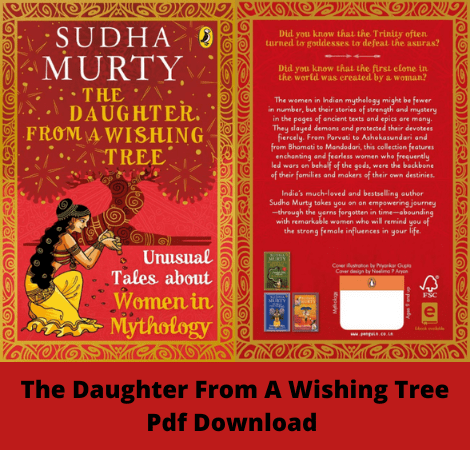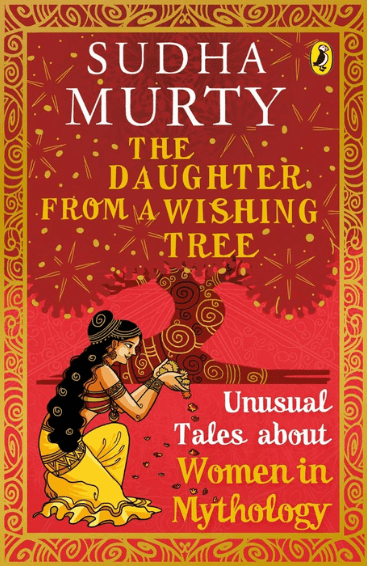The Daughter from a Wishing Tree-Unusual Tales About Women in Mythology.You may know a lot about Krishna and Lord Rama, but how much do you know about Indian mythology’s women? You should get your hands on the book “The Daughter from a Wishing Tree- Unusual Tales About Women in Mythology” if you want to expose yourself or your children to mythology’s magnificent ladies. Sudha Murty’s powerful narrative brings the achievements and fates of Parvati, Bhamati, Mandodari, and others to life. Although there are fewer women in Indian mythology, there are numerous stories of courage and mystery in ancient writings and epics. They fought demons and zealously guarded their followers.
She states in her preface that she was unable to discover many stories when she was writing this book, either because it is a male-dominated culture or because most stories are authored by males, or most likely both. Most of us associate women in mythology with Draupadi from the Mahabharata, Sita from the Ramayana, and several well-known Durga legends. So, relying on the stories she heard and read as a kid, she has created this lovely collection of tales that exposes us to a variety of powerful women figures from Indian mythology, as well as the significance of many festivals and idols observed throughout India.
| Name | The Daughter From A Wishing Tree |
| Author | Sudha Murthy |
| Publisher | Puffin |
| Pages | 192 |
| Language | English |
Also Download : The Day I Stopped Drinking Milk by Sudha Murthy Books | Something Happened on the Way to Heaven: 20 Inspiring Real-Life Stories by Sudha Murthy
The Daughter From A Wishing Tree by Sudha Murthy Books Pdf Download
This book contains 24 charming stories, all of which are accompanied by gorgeous drawings, making it an appealing and unforgettable read. The book begins with a few of the more famous goddesses, such as Lakshmi and Saraswati, but it also presents readers with lesser-known deities such as Amba, Ashokasundari, Ashtalakshmi, Shatakshi, Devayani, Sanjna, and Vasavadatta, Nal-Damayanti, Kach-devyani, Urvashi-Suryadeva, Chyavan-Sukanya, Sharmistha, etc and Murty puts to life some of their lesser-known deeds, even among the more known goddesses.

‘The Daughter from a Wishing Tree,’ the cover tale, follows Goddess Parvati as she visits the Nandana Garden in Amravati, the capital of Lord Indra’s dominion, and makes a wish to Kalpavriksha, the Wishing Tree, for a daughter. ‘The Source of Knowledge’ narrates the story of Lord Brahma creating Saraswati, the Goddess of Knowledge and wisdom. Brahma wished for an intellectual partner while he was constructing this planet. When the assuras realized that the book of knowledge in goddess Saraswati’s possession was the reason for their defeat in the battle against the devas, they managed to steal the book and flee to earth. Goddess Saraswati took the form of rive to catch the assuras and returned to Brahma, but a small portion of her power continued to flow like a river named Saraswati on earth.
‘The Woman of the Battlefield’ explains how Goddess Durga acquires her eight signature weapons and goes on to fight Mahishasura, the asura who had wrought devastation on the world and, then, in the Gods’ realm. True Love’s Two Stars (Arundhati and Vasishtha) . Although there was violence in this narrative, Arundhati and Vasishtha did not go to battle. They made use of language. What I liked best was how they worked together as partners and equals to achieve a common objective – knowledge. Their altruism, moral conscience, and dedication to study are qualities to emulate and remember.
Soldiers in the Elephant’s Stomach (Vasavadatta and Udayana) . Another tale of two kingdoms that chose intellect above battle to achieve their goals. The story of how the young king Udayana met his true love, Vasavadatta, the abdication Vasavadatta gave for the kingdom’s benefit, and Udayana’s love and adoration for Vasavadatta all touched my heart.
Shurpanaka’s story is one of a kind. Shurpanakha was viewed as only a plot device to draw Ram into the conflict, a minor trigger in a wider scheme of things to which she is not a participant, a woman deceitful and envious of another women’s beauty, and a lady who “rightfully” suffers the amputation of her nose. This was compounded in our memories of abbreviated and picture-heavy children’s Ramayanas by presenting Shurpanakha as an ugly, generally grey- omplexioned rakshasa lady with a snout for a nose who deserved what she got. Here, Shurpanakha of Lanka schemes to seek retribution for a shattered heart, refusing to be bound by patriarchal ideals of the generous-but-brave, forgiving yet fierce archetype of the female warrior.
The Daughter From A Wishing Tree Full Book Pdf Download by Sudha Murthy Books
The book mentions the origins of Yadavas and Kurus and many myths regarding the origins of the gods we worship today including stories about Vishwakarma’s and Shukracharya’s daughters. This novel featured both educated and cunning and haughty ladies. Other than women empowerment, another lesson is that responding without thinking has repercussions that can be nastier than the original crime and even enduring, as evidenced by the fact that in some stories, when the offending party noticed they had been too tough with their curse and wished to take their words back after calming down, they couldn’t. For example, when Shukracharya cursed Yayati to lose his youth at his daughter Devyani’s request, he had to amend the curse since he felt terrible for the king. Even if the curse was adjusted, it could never be reversed. This book falls in between the “fiction” and “non-fiction” Mythology sub-genres. Puranas can be both history and fables, based on one’s point of view.
If you wish to read mythological stories and use them as examples in your daily life, this book is the right pickup. In India, mythology has always played a vital role in a child’s upbringing. We are all familiar with Sita and Draupadi’s divinity, courage, and sorrow. But if there are more mythological women with stories to tell, lessons to teach, and ideals to implant in us, wouldn’t it be a perfect blessing? From the creation of Ashokasundari to Arjuna constructing an arrow staircase to Indra’s palace, the unique account of Shakambhari’s existence to the arrogant asura brothers Karambha and Rambha, this book has it all.

